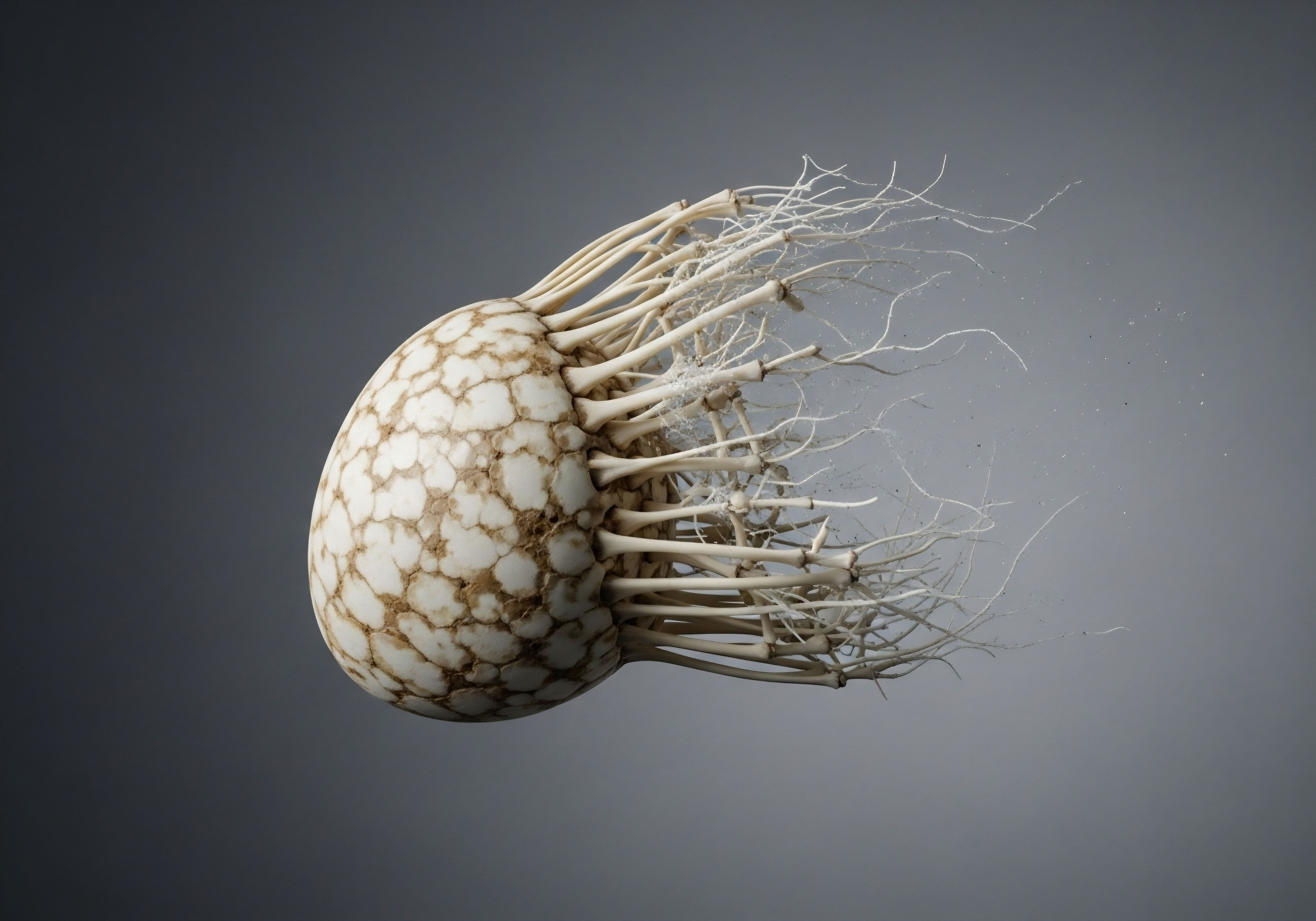

Fundamentals
You feel it before you can name it. A persistent sense of fatigue that sleep does not seem to touch, a subtle shift in your mood that casts a grey filter over your days, or a frustrating change in your body’s composition despite your best efforts with diet and exercise.
These experiences are real, they are valid, and they are often the first signals that your body’s internal communication network is experiencing interference. This network, the endocrine system, is a breathtakingly complex web of glands and chemical messengers called hormones that dictates everything from your energy levels and metabolic rate to your stress response and reproductive health. Your lived experience of wellness is a direct reflection of the clarity and efficiency of these internal communications.
Understanding your hormonal health begins with understanding that your body is constantly sending and receiving information. Lifestyle choices are a primary source of this information. The food you consume, the way you move your body, the quality of your sleep, and the stress you manage are all powerful inputs that your endocrine system translates into biochemical instructions.
When these inputs are consistently nourishing and supportive, the system functions with precision. When the inputs are disruptive, the messages can become distorted, leading to the symptoms you may be experiencing. Therefore, the question of altering hormonal lab markers through lifestyle is a profound one.
It speaks to the very foundation of personal agency in health. It confirms that you are not a passive recipient of your genetic inheritance but an active participant in your own biological story. The numbers on a lab report are simply data points, objective measurements of your internal hormonal environment at a single moment in time. They provide a map, and with that map, you can begin to see how your daily actions sculpt your internal landscape.

The Language of Your Biology
Hormones are the chemical alphabet of your body. They are molecules synthesized in one part of the body, released into the bloodstream, and then travel to distant cells and tissues to exert their effects. Think of them as missives sent from a central command center to field agents, carrying specific instructions.
For these messages to be received correctly, the receiving cells must have functional receptors, akin to a properly tuned radio antenna. The entire process is a delicate dance of production, transport, reception, and eventual breakdown and clearance. Lab markers are our window into this dance. They measure the concentration of these hormones in your blood, saliva, or urine, giving us a quantitative snapshot of your endocrine status.
For men, key markers often include total and free testosterone, sex hormone-binding globulin (SHBG), estradiol, and luteinizing hormone (LH). For women, the picture is often more complex, involving the cyclical interplay of estradiol, progesterone, LH, and follicle-stimulating hormone (FSH), with testosterone also playing a vital role in vitality and well-being.
For both sexes, hormones like cortisol (the primary stress hormone), DHEA (a precursor hormone), and the suite of thyroid hormones (TSH, T3, T4) are fundamental to metabolic function and overall energy. These markers do not exist in isolation.
They are part of intricate feedback loops, most notably the Hypothalamic-Pituitary-Gonadal (HPG) axis for sex hormones and the Hypothalamic-Pituitary-Adrenal (HPA) axis for the stress response. These axes function like sophisticated thermostats, constantly monitoring hormone levels and adjusting production up or down to maintain a state of dynamic equilibrium, or homeostasis.
Your daily habits provide the critical data that your body’s hormonal systems use to regulate your health and vitality.

How Lifestyle Becomes Biology
Every choice you make is a piece of biological information. A meal high in refined carbohydrates and sugars sends a powerful signal to your pancreas to release insulin. Chronic overstimulation can lead to insulin resistance, a state where your cells become less responsive to insulin’s message.
This condition has profound downstream effects, including altering SHBG levels, which in turn affects the amount of free, bioavailable testosterone and estrogen in your system. Adipose tissue, or body fat, is an active endocrine organ itself. It produces its own set of signaling molecules and contains the enzyme aromatase, which converts testosterone into estrogen. An increase in adipose tissue can therefore directly alter the ratio of these critical sex hormones, impacting both men and women.
Conversely, a lifestyle rich in nutrient-dense whole foods, consistent physical activity, restorative sleep, and effective stress modulation sends a very different set of signals. It provides the raw materials for hormone synthesis, such as cholesterol for steroid hormones and amino acids for peptide hormones. It enhances cellular sensitivity to hormonal messages.
It helps maintain a healthy body composition, which directly supports a more favorable hormonal profile. It regulates the HPA axis, preventing the chronic elevation of cortisol that can suppress reproductive function and thyroid activity. In this context, lifestyle interventions are the most fundamental form of personalized medicine.
They are a way of speaking to your body in its own language, using the inputs of daily life to guide your biological systems toward a state of optimal function and well-being. The changes you see on a lab report are the documented results of this conversation.
This journey into understanding your hormones is about reclaiming a sense of control. It is about recognizing that the way you feel is not arbitrary. It is a direct physiological response to your internal environment, and that environment is significantly shaped by your actions. The goal is to align your lifestyle with your biology, creating a foundation of health that allows your endocrine system to perform its intricate and life-sustaining work without compromise.


Intermediate
Advancing from the foundational understanding that lifestyle influences hormonal health, we can now examine the specific mechanisms through which these changes are enacted. The endocrine system is a highly responsive and adaptive network. It is designed to interpret environmental cues and adjust its output accordingly.
When we speak of “lifestyle interventions,” we are referring to a targeted application of these cues to encourage a specific, favorable biological response. This process is analogous to tuning a complex instrument. Each intervention ∞ be it nutritional, physical, or restorative ∞ adjusts a different string, and the collective result is a harmonized system reflected in your lab markers.

Nutritional Modulation of Endocrine Pathways
Nutrition provides the fundamental building blocks and regulatory cofactors for the entire endocrine cascade. The composition of your diet directly informs hormone production, transport, and clearance. Examining macronutrients and micronutrients reveals their distinct roles in this process.

The Role of Macronutrients
The balance of proteins, fats, and carbohydrates in your diet creates a cascade of hormonal responses, with insulin being one of the most immediate and impactful. A diet pattern that helps maintain insulin sensitivity is a cornerstone of hormonal health.
- Fats ∞ Dietary fats, particularly cholesterol, are the direct precursors to all steroid hormones, including testosterone, estrogen, progesterone, and cortisol. Insufficient intake of healthy fats can compromise the body’s ability to synthesize these vital messengers. Omega-3 fatty acids, found in fatty fish and flaxseeds, possess anti-inflammatory properties that can improve cellular health and receptor sensitivity.
- Proteins ∞ Adequate protein intake is necessary for muscle maintenance and growth, which influences insulin sensitivity. Amino acids are also the building blocks for peptide hormones and are crucial for the liver’s detoxification pathways, which are responsible for metabolizing and clearing hormones from the body. Protein consumption also has a direct effect on satiety hormones like ghrelin and leptin.
- Carbohydrates ∞ The type and quantity of carbohydrates consumed profoundly affect insulin and cortisol levels. High-glycemic, processed carbohydrates can lead to sharp insulin spikes. Over time, this can contribute to insulin resistance, a condition where cells no longer respond efficiently to insulin. This metabolic state is linked to elevated inflammation and can disrupt the HPG axis. For instance, high insulin levels can lower SHBG, leading to altered levels of free sex hormones.

Micronutrients as Essential Cofactors
While macronutrients provide the fuel and building blocks, micronutrients are the spark plugs. They act as essential cofactors in the enzymatic reactions that govern hormone synthesis and metabolism.
Vitamins and minerals like zinc, magnesium, and vitamin D are particularly important. Zinc is a critical mineral for testosterone production and thyroid health. Magnesium is involved in hundreds of enzymatic reactions, including those that regulate blood sugar and the stress response.
Vitamin D, which functions as a pro-hormone, has receptors in nearly every cell in the body and has been shown to correlate with healthy testosterone levels. Deficiencies in these key micronutrients can create significant bottlenecks in endocrine pathways, even when macronutrient intake is adequate.
| Dietary Approach | Primary Mechanism of Action | Potential Impact on Key Lab Markers |
|---|---|---|
| Mediterranean Diet | Rich in anti-inflammatory monounsaturated fats and omega-3s, high in fiber and antioxidants. | May improve insulin sensitivity (lower HOMA-IR), reduce inflammatory markers (CRP), and support healthy lipid profiles. |
| Low-Glycemic Diet | Focuses on minimizing sharp increases in blood glucose and insulin. | Directly targets insulin resistance (lower fasting insulin, HOMA-IR), which can lead to increased SHBG and a more balanced free androgen index. |
| Ketogenic/Very Low-Carb Diet | Shifts primary energy source from glucose to ketones, drastically lowering insulin levels. | Significant reduction in insulin. May increase total testosterone in some individuals, but effects on free testosterone can be variable due to potential changes in SHBG. |

Physical Activity as an Endocrine Stimulus
Exercise is a potent, non-pharmacological modulator of the endocrine system. The type, intensity, and duration of physical activity determine the specific hormonal response elicited. Different forms of exercise send distinct signals to the body.

Resistance Training
Lifting heavy weights creates a significant metabolic demand and micro-trauma to muscle fibers. The repair and growth process that follows stimulates the release of several anabolic hormones. Acutely, resistance training can trigger a post-workout spike in testosterone and growth hormone.
Over the long term, consistent training increases muscle mass, which acts as a glucose sink, dramatically improving whole-body insulin sensitivity. This is a primary mechanism through which resistance training helps regulate blood sugar and, by extension, supports a healthier hormonal milieu.

High-Intensity Interval Training (HIIT)
HIIT involves short bursts of all-out effort followed by brief recovery periods. This type of training is a powerful stimulus for the release of catecholamines (adrenaline and noradrenaline) and can significantly increase growth hormone output. It is also highly effective at improving insulin sensitivity and mitochondrial density in a time-efficient manner. The acute stress of a HIIT session, when properly balanced with recovery, can make the body’s stress-response system more resilient over time.
Targeted exercise protocols and optimized sleep hygiene are powerful tools for recalibrating the body’s hormonal communication systems.

The Foundational Role of Sleep and Stress Regulation
The most sophisticated diet and exercise plan can be completely undermined by inadequate sleep and chronic stress. These two factors exert a powerful, top-down influence on the entire endocrine system, primarily through their regulation of the HPA axis.

Sleep the Great Calibrator
Sleep is a critical period of hormonal regulation and recalibration. During deep sleep, the body releases the majority of its daily growth hormone, which is essential for cellular repair. The natural circadian rhythm dictates a peak in cortisol levels in the early morning to promote wakefulness, followed by a gradual decline throughout the day.
Sleep deprivation disrupts this rhythm, often leading to elevated cortisol levels in the evening, which can interfere with sleep onset and suppress the production of other hormones. A single night of poor sleep can temporarily reduce insulin sensitivity and alter testosterone production. Chronic sleep debt creates a state of low-grade systemic stress that negatively impacts virtually all hormonal systems.

Managing the Cortisol Cascade
The HPA axis is the body’s central stress response system. When faced with a stressor ∞ be it psychological, emotional, or physical ∞ the hypothalamus releases CRH, which signals the pituitary to release ACTH, which in turn tells the adrenal glands to produce cortisol. This is a healthy and necessary survival mechanism.
The problem arises when this system is chronically activated. Persistently high cortisol levels can have widespread catabolic effects. It can promote the breakdown of muscle tissue, increase blood sugar, suppress immune function, and interfere with thyroid hormone conversion. Perhaps most critically, it can suppress the HGP axis, leading to lower levels of sex hormones.
This phenomenon, known as the “cortisol steal,” occurs because the precursor hormone pregnenolone is diverted toward cortisol production at the expense of DHEA and other downstream sex hormones. Therefore, lifestyle interventions that focus on stress management ∞ such as meditation, deep breathing exercises, and mindfulness ∞ are direct interventions for hormonal health. They work by down-regulating the HPA axis, thereby reducing the chronic cortisol load and allowing other hormonal systems to function without suppression.


Academic
A sophisticated analysis of the impact of lifestyle interventions on hormonal lab markers requires moving beyond generalized principles and into the specific, interconnected pathways of systems biology. The interplay between adipose tissue, systemic inflammation, and the Hypothalamic-Pituitary-Gonadal (HPG) axis in the context of obesity-associated male hypogonadism presents a compelling case study.
This condition, characterized by low testosterone levels in the presence of excess body fat, provides a clear lens through which to view the powerful, and sometimes limited, effects of diet and exercise on endocrine function.

Adipose Tissue as a Pro-Inflammatory Endocrine Organ
Historically viewed as a passive storage depot for energy, adipose tissue is now understood to be a highly active and complex endocrine organ. It synthesizes and secretes a wide array of signaling molecules known as adipokines, including leptin, adiponectin, and various pro-inflammatory cytokines such as Tumor Necrosis Factor-alpha (TNF-alpha) and Interleukin-6 (IL-6).
In a lean individual, adipose tissue secretes a higher proportion of anti-inflammatory molecules like adiponectin. As adiposity increases, particularly visceral adiposity, the tissue becomes dysfunctional. Adipocytes become hypertrophic and hypoxic, leading to cellular stress, death, and the infiltration of immune cells, particularly macrophages. This process transforms the adipose tissue into a primary source of chronic, low-grade systemic inflammation.
This inflammatory state has direct and profound consequences for hormonal regulation. Pro-inflammatory cytokines like TNF-alpha and IL-6 can cross the blood-brain barrier and act directly on the hypothalamus and pituitary gland. They have been shown to suppress the pulsatile release of Gonadotropin-Releasing Hormone (GnRH) from the hypothalamus, which is the master signal for the entire HPG axis.
This, in turn, reduces the secretion of Luteinizing Hormone (LH) and Follicle-Stimulating Hormone (FSH) from the pituitary. With diminished LH signaling, the Leydig cells in the testes reduce their production of testosterone. This establishes a direct mechanistic link between excess body fat, inflammation, and central hypogonadism.

Aromatase and the Estrogen-Testosterone Balance
Adding another layer of complexity is the role of the enzyme aromatase, which is highly expressed in adipose tissue. Aromatase catalyzes the irreversible conversion of androgens (like testosterone) into estrogens (like estradiol). In men with significant adiposity, this enzymatic activity is substantially increased.
The result is a dual assault on the hormonal profile ∞ decreased testosterone production due to inflammatory suppression of the HPG axis, and increased conversion of the remaining testosterone into estradiol. Elevated estradiol levels further suppress the HPG axis through negative feedback at the hypothalamic and pituitary levels, creating a self-perpetuating cycle of worsening hypogonadism.
This biochemical environment is reflected in lab reports as low total and free testosterone, often accompanied by normal or low-normal LH and elevated estradiol levels.
The metabolic state of adipose tissue directly influences systemic inflammation, which in turn modulates the central regulation of sex hormones.

What Are the Clinical Trial Data for Lifestyle Interventions?
Given this pathophysiology, lifestyle interventions targeting weight loss are the logical first-line approach. Randomized controlled trials provide the most robust evidence for their efficacy. A key study by Villareal et al. (2016) examined the effects of a 12-month diet and exercise program in frail, obese older men.
The intervention groups achieved a significant weight loss of approximately 9-10%. This weight loss led to statistically significant decreases in both total estradiol and the free estradiol index. This demonstrates that reducing the amount of adipose tissue successfully reduces the total aromatase activity in the body.
The study also found a statistically significant increase in total testosterone levels. This appears to confirm the hypothesis that reducing the inflammatory and estrogenic burden of excess fat can improve HPG axis function. The nuance, however, lies in the other markers. The lifestyle intervention also caused a significant increase in Sex Hormone-Binding Globulin (SHBG).
SHBG is a protein that binds to sex hormones in the bloodstream, rendering them biologically inactive. Because of this concurrent rise in SHBG, the calculated free testosterone index, which represents the bioavailable fraction of the hormone, did not show a significant increase from baseline. This finding is critically important.
It illustrates that while lifestyle changes can move some lab markers in a favorable direction, they may not be sufficient to fully restore a eugonadal state, particularly in older populations or those with significant metabolic derangement. The men in the study, despite improvements, often remained in the hypogonadal range as defined by clinical guidelines.
| Hormonal Marker | Diet Group Change | Diet-Exercise Group Change | Clinical Interpretation |
|---|---|---|---|
| Weight (kg) | -10.1 kg | -9.1 kg | Significant reduction in adipose tissue mass, the primary driver of hormonal disruption. |
| Total Estradiol (pg/mL) | -2.5 pg/mL | -2.2 pg/mL | Decreased aromatase activity due to fat loss, reducing negative feedback on the HPG axis. |
| Total Testosterone (ng/dL) | +71.0 ng/dL | +49.9 ng/dL | Statistically significant increase, but final values often remained below the eugonadal range. |
| SHBG (nmol/L) | Significant Increase | Significant Increase | Weight loss and improved insulin sensitivity often raise SHBG, which binds testosterone. |
| Free Testosterone Index | No Significant Change | No Significant Change | The rise in SHBG offset the increase in total testosterone, resulting in no net gain in bioavailable hormone. |

How Do Inflammatory Markers Respond to Diet Composition?
The composition of the diet itself, independent of weight loss, can also modulate the inflammatory milieu. Research on the metabolic syndrome, a condition closely linked to hormonal imbalance, shows that dietary patterns have a profound effect on inflammatory markers like C-reactive protein (CRP).
Studies examining the effects of a Mediterranean-style diet, for example, have found significant reductions in CRP and other markers of vascular inflammation. This effect is attributed to the high intake of monounsaturated fats, omega-3 fatty acids, polyphenols, and fiber, all of which have known anti-inflammatory properties.
This suggests that the quality of the food consumed sends its own set of signals to the immune system, which can then influence endocrine function. A diet designed to lower inflammation may therefore be a crucial component of any lifestyle protocol aimed at hormonal optimization.
These clinical findings underscore a critical point. Lifestyle interventions are a powerful and necessary foundation for hormonal health. They can significantly alter lab markers related to inflammation, estrogen dominance, and insulin resistance. They can produce meaningful improvements in total testosterone. The human body’s systems are deeply interconnected.
The effect of an intervention on one marker, like total testosterone, can be modulated by its effect on another, like SHBG. For some individuals, particularly those with more severe or long-standing hormonal disruption, lifestyle changes alone may not be sufficient to restore optimal physiological function. In these cases, the foundational work done through diet and exercise creates a healthier internal environment that can then be more responsive to further therapeutic support, such as targeted hormone replacement or peptide therapies.
- Systemic Inflammation ∞ Chronic low-grade inflammation, often measured by markers like high-sensitivity C-reactive protein (hs-CRP), acts as a global suppressor of endocrine function, particularly at the level of the hypothalamus and pituitary.
- Insulin Resistance ∞ This metabolic state, measured by fasting insulin and HOMA-IR, directly impacts SHBG levels. Higher insulin levels suppress SHBG production by the liver, leading to lower levels of bound testosterone and a potential alteration in the free hormone fraction.
- Nutrient Availability ∞ The presence of key substrates (cholesterol, amino acids) and enzymatic cofactors (zinc, magnesium, vitamin D) is a rate-limiting factor in the synthesis of all hormones. Deficiencies can be identified through specific blood tests.

References
- Armamento-Villareal, R. Aguirre, L. E. Qualls, C. & Villareal, D. T. (2016). Effect of Lifestyle Intervention on the Hormonal Profile of Frail, Obese Older Men. The journal of nutrition, health & aging, 20 (3), 334 ∞ 340.
- Endocrine Associates of West Village. (n.d.). How Lifestyle Changes Can Help Restore Your Hormonal Health. Retrieved from Endocrine Associates of West Village website.
- Nelson Hospital. (2024). How Lifestyle Choices Affect Hormonal Imbalance in Women in 2024? Retrieved from Nelson Hospital website.
- Beavers, K. M. & Nicklas, B. J. (2011). Effects of lifestyle interventions on inflammatory markers in the metabolic syndrome. Frontiers in bioscience (Scholar edition), 3 (1), 168 ∞ 177.
- My Labs Direct. (n.d.). Unleashing The Power Of Hormonal Balance ∞ How Blood Testing Helps Achieve Weight Loss Goals. Retrieved from My Labs Direct website.

Reflection

Your Biology Is Listening
You have now seen the intricate machinery that operates beneath the surface of your daily experience. You understand that the feelings of vitality, energy, and well-being are not products of chance, but the output of a biological system that is constantly listening.
It listens to the information contained in your food, the stress of your movements, the depth of your rest, and the weight of your thoughts. The data on a lab report is a transcript of this conversation, a reflection of how your body has interpreted the signals you have provided.
This knowledge places you in a position of profound collaboration with your own physiology. The path forward is one of informed action, of choosing the signals you send with intention. It is a process of recalibration, where each meal, each workout, and each night of restorative sleep is an opportunity to guide your systems toward their innate potential for balance and function.
Your personal health journey is unique to you, and understanding the language of your own biology is the first, most powerful step toward navigating that path with clarity and purpose.



